Alcohols:
Alcohols are the compound in which hydroxyl (-OH) group is attached to saturated carbon atom. The hydroxyl group is the functional group of alcohols. Alcohols containing one hydroxyl group, called Monohydric Acohols. Alcohols with two or more hydroxyl groups, called dihydric alcohols, Trihydric alcohols, and polyhydric alcohols respectively. For example,
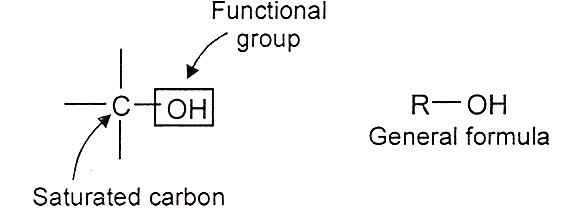
 Monohydric alcohols contain only one –OH group attached to a saturated carbon. They may be represented as (R-OH). Monohydric alcohols are classified as primary, secondary, or tertiary depending upon whether the –OH group is attached to a primary, a secondary, or a tertiary carbon.
Monohydric alcohols contain only one –OH group attached to a saturated carbon. They may be represented as (R-OH). Monohydric alcohols are classified as primary, secondary, or tertiary depending upon whether the –OH group is attached to a primary, a secondary, or a tertiary carbon.

Orbital structure of alcohols:
Let us consider methyl alcohol (CH3OH) to explain the orbital structure of alcohols. In methyl alcohol both oxygen and carbon are sp3 hybridized. Two of the sp3 orbital of oxygen are completely filled and cannot take part in bond formation. The C-O bond in methyl alcohol is formed by overlap of an sp3 orbital of carbon and sp3 orbital of oxygen. The O-H bond is formed by the overlap of an sp3 orbital of oxygen and s-orbital of hydrogen. The C-O-H bond angle is 105º. It is less than the normal tetrahedral angle. It is due to the two completely filled sp3 orbital of oxygen repel each other. This results in the reduction of the bond angle.
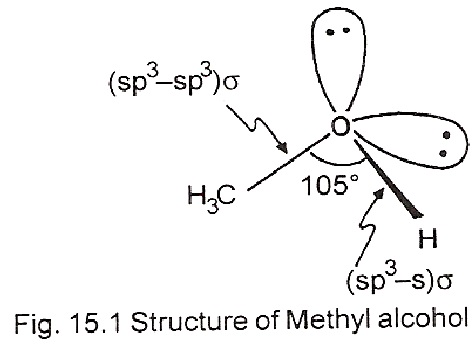
Preparation of Alcohols:
Alcohols are prepared by the following methods:
Hydrolysis of alkyl halides: Alcohol is prepared by heating alkyl halides with aqueous solution of sodium hydroxide or KOH.

Hydration of Alkene: Alkene reacts with sulphuric acid to produce alkyl hydrogen sulphate which on hydrolysis give alcohols. e.g.
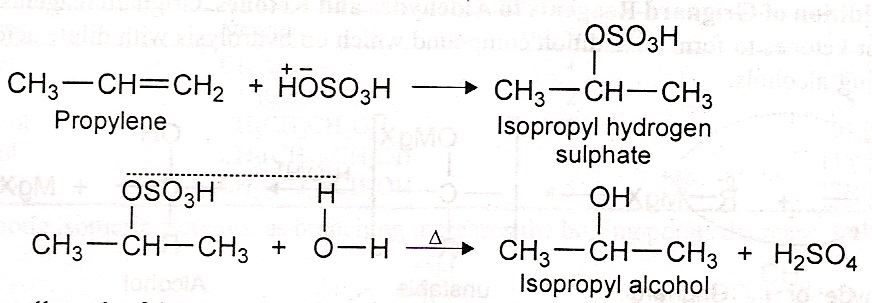 Hydrolysis of ester: Alcohols can be prepared by base or acid-catalysed hydrolysis of ester.
Hydrolysis of ester: Alcohols can be prepared by base or acid-catalysed hydrolysis of ester.
 From Aldehyde and Ketones: Grignard reagents react with aldehyde and ketones to form an addition compound which on hydrolysis with dilute acid gives the corresponding alcohols.
From Aldehyde and Ketones: Grignard reagents react with aldehyde and ketones to form an addition compound which on hydrolysis with dilute acid gives the corresponding alcohols.
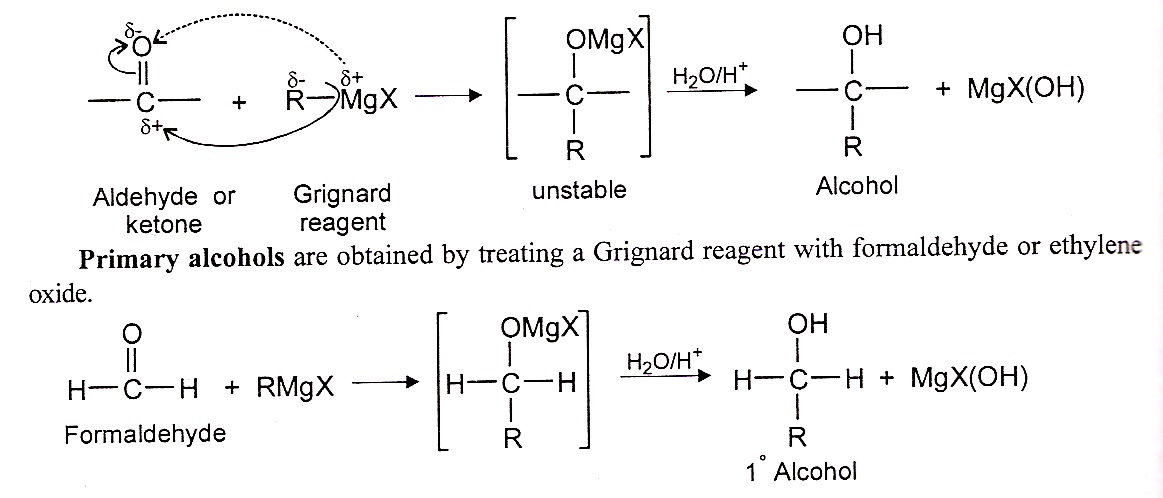
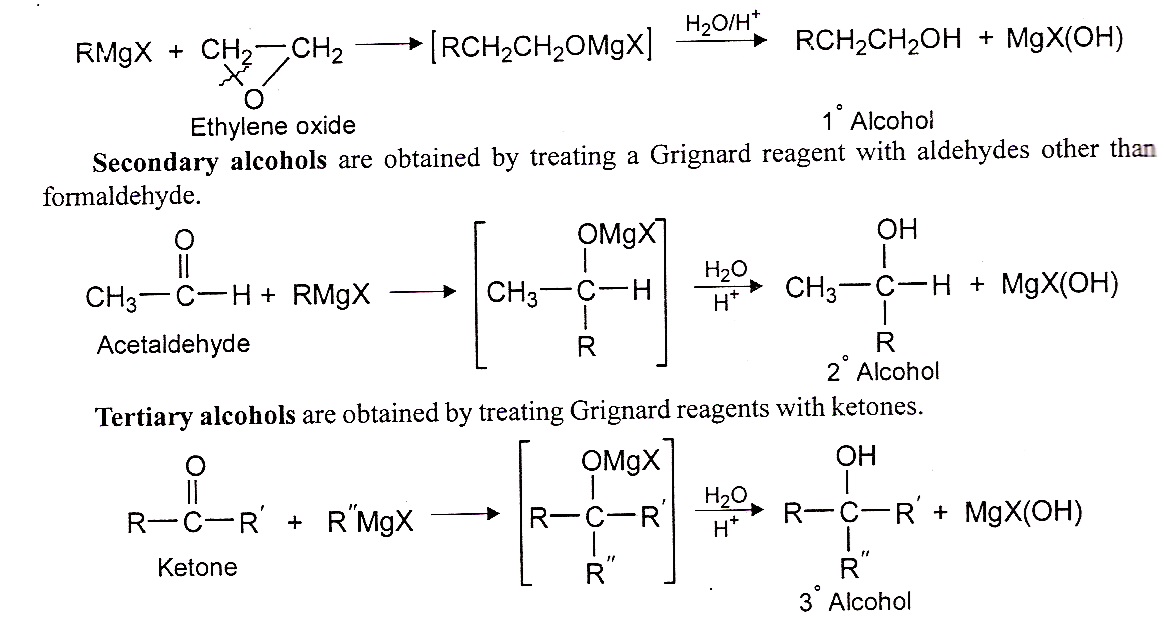
Physical properties of Alcohols:
The lower alcohols are colourless, toxic liquids. They have characteristic smell. Boiling points of alcohols increase regularly with the increase in the number of carbon atoms. The boiling point of alcohols are much higher than that of corresponding alkenes.
The O-H bond of alcohols is highly polar because oxygen is electronegative. The oxygen is carries a partial negative charge (δ–). The hydrogen carries a partial positive charge (δ+). The polarity of the O-H bond gives rise to forces of attraction between a partially positive hydrogen in one molecule and partially negative oxygen in another molecule. These forces of attraction is called as Hydrogen bonding. The reason that alcohols have higher boiling points is that a great deal of energy is required to overcome these attractive forces.
Alkanes, on the other hand do not have H-bonding. Therefore, their boiling points are low. Lower alcohols are completely soluble in water. As we go higher in the series, the water solubility falls rapidly.
Chemical properties: Alcohols are reactive compounds. They are attracted by polar or ionic compound. This is because:
- The C-O and O-H bonds of alcohols are polar since oxygen is highly electronegative.
- The oxygen atom of alcohols is an electron rich centre because it has two unshared pairs of electrons.
1) Acidic Characters of Alcohols: Alcohols are weak acids. Alcohols are treated with sodium or potassium to form alkoxides with the liberation of hydrogen gas.
![]() The above reaction shows that alcohols are acidic in nature. The reason for this is that the O-H bond in alcohols is polar and allows the release of the hydrogen atom as proton (H+). However, alcohols are weaker acid than water. This is because of alkyl groups in alcohols have a +I effect. They release electron towards the oxygen atom so that it becomes negatively charged. This negative charge on oxygen makes the release of the positive proton more difficult. Tirtiary alcohols are less acidic than secondary alcohols . The secondary alcohols are less acidic than primary alcohols due to the +I effect would be maximum in tertiary alcohols, as they contain three alkyl groups attached to the carbon bearing the –OH group.
The above reaction shows that alcohols are acidic in nature. The reason for this is that the O-H bond in alcohols is polar and allows the release of the hydrogen atom as proton (H+). However, alcohols are weaker acid than water. This is because of alkyl groups in alcohols have a +I effect. They release electron towards the oxygen atom so that it becomes negatively charged. This negative charge on oxygen makes the release of the positive proton more difficult. Tirtiary alcohols are less acidic than secondary alcohols . The secondary alcohols are less acidic than primary alcohols due to the +I effect would be maximum in tertiary alcohols, as they contain three alkyl groups attached to the carbon bearing the –OH group.
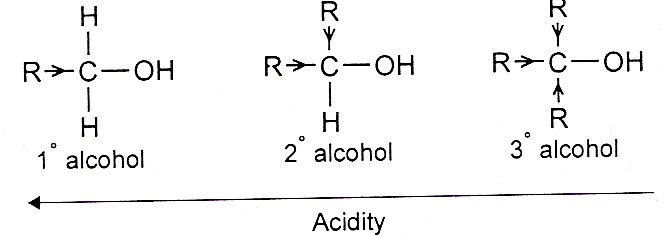 N.B.: Alcohols are not acidic enough to react with aqueous NaOH or KOH.
N.B.: Alcohols are not acidic enough to react with aqueous NaOH or KOH.
2) Reaction with Phosphorus Halides: Alcohols react with phosphorus Pentahalides (PX5) and phosphorus trihalides (PX3) to give alkyl halides.
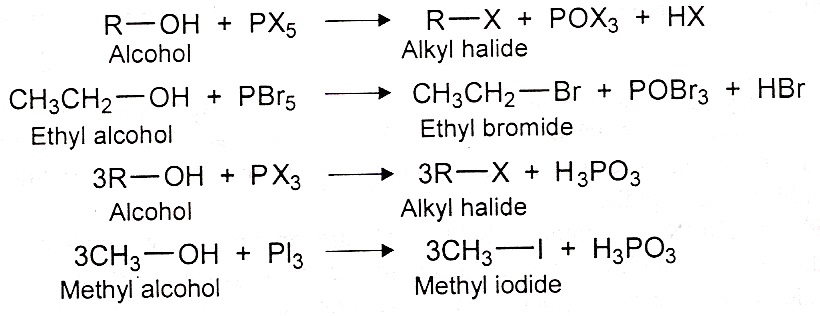 3) Reaction with metal Hydrides: Alcohols react with metal hydrides to form salts along with the evolution of hydrogen gas.
3) Reaction with metal Hydrides: Alcohols react with metal hydrides to form salts along with the evolution of hydrogen gas.
R-OH + NaH —–→ RONa + H2
e.g. CH3CH2OH + NaH —–→ CH3CH2ONa + H2
4) Reaction with hydrogen Halides: When alcohols treated with hydrogen halides, to form alkyl halides.
R—OH + HX → R—X + H2O
e.g. CH3CH2 –OH + HBr—-> CH3CH2Br + H2O
- Tertiary alcohols reacts with hydrogen halides
- Secondary alcohols reacts somewhat slower
- Primary alcohols even more slow.
- The order of the reactivity of hydrogen halides is HI>HBr>HCl. HCl reacts only with hydrogen halides in presence of catalyst (Anhy.ZnCl2).
- Tertiary and secondary alcohols react with hydrogen halides by SN2 mechanism.
5) Reaction with Sulhpuric acid: Alcohols reacts with sulphuric acid at different conditions giving different products. For example,
- When ethyl alcohol is treated with conc. Sulphuric acid at room temperature (or 383K) ethyl hydrogen sulphate is produced.

- When alcohols is reacts with conc. sulphuric acid at 443 K ethylene is formed.
CH3 – CH2 – OH + conc. H2SO4 at 170ºc > CH2=CH2 + H2O
Ethyl alcohol Ethylene
- Excess of ethyl alcohol when treated with conc. sulphuric acid at about 140ºC (413K) diethyl ether is formed.

6) Reaction with Carboxylic acid: Alcohol reacts with carboxylic acid in presence of conc. sulphuric acid to form ester.
R –OH + HOOC-R ——-> R─OOC – R + H2O
Alcohol acid Ester
e.g. CH3-CH2 –OH + CH3COOH → CH3COOC2H5 + H2O
Ethyl alcohol Acetic acid Ethyl acetate (Ester)
7) Reaction with acid halides and acid anhydrides: Alcohols reacts with acid halides and acid anhydride to form ester.

8) Reaction with Grignard reagents: When alcohol treated with Grignard reagents (RMgX) to form alkanes.

9) Oxidation of alcohols: Alcohols undergo oxidation with mild oxidising agents like acidified solution of potassium permanganate or potassium dichromate giving products depending on the type of alcohol and the conditions of the reaction.
- Primary alcohols are first oxidised to aldehyde and then to acids

- Secondary alcohols oxidised to ketones

- Tertiary alcohols are stable to oxidation under normal condition
